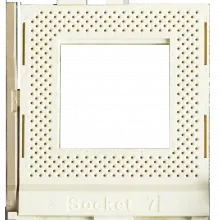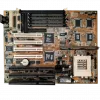
Socket 7 is a CPU socket type that was commonly used in the late 1990s for desktop and low-end server motherboards. It played a significant role in the transition from 486-class processors to the early generation of Pentium processors. Here are some key features and characteristics of Socket 7:
-
Compatibility: Socket 7 was designed to accommodate a variety of CPU types, including Intel Pentium, AMD K5, and Cyrix 6x86 processors. This compatibility made it a versatile choice for motherboard manufacturers and consumers.
-
Physical Design: Socket 7 featured 321 pin holes and a ZIF (Zero Insertion Force) design, which allowed for easy installation and removal of CPUs without the need for force.
-
Voltage Regulation: Early CPUs used in Socket 7 motherboards operated at different voltage levels, which necessitated voltage regulation on the motherboard itself. This was an important feature for compatibility.
-
Clock Speeds: Socket 7 motherboards supported a wide range of clock speeds and bus frequencies, which contributed to the flexibility of the platform.
-
Cache Memory: Motherboards using Socket 7 often featured cache memory to enhance CPU performance. This cache memory could be either on the motherboard or on the CPU itself.
-
Legacy Interface Support: Socket 7 motherboards typically included legacy interfaces such as ISA slots for compatibility with older expansion cards.
-
Replacement of Socket 5: Socket 7 succeeded Socket 5 and provided an improved platform for the next generation of processors.
Socket 7 played a pivotal role during the transition from 486 processors to early Pentium CPUs and their competitors. While it is now considered obsolete, it represents a notable chapter in the history of CPU socket designs, showcasing the importance of compatibility and flexibility during an era of rapid technological advancement in the PC industry.
